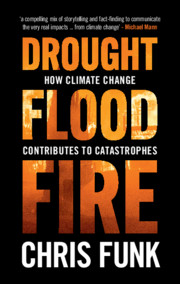Book contents
- Drought, Flood, Fire
- Drought, Flood, Fire
- Copyright page
- Contents
- Acknowledgments
- 1 Climate Extremes, Climate Attribution, Extreme Event Attribution
- 2 Welcome to an Awesome Planet
- 3 The Earth Is a Negentropic System, or “the Bright Side of Empty”
- 4 Do-It-Yourself Climate Change Science
- 5 Temperature Extremes – Impacts and Attribution
- 6 Precipitation Extremes
- 7 Hurricanes, Cyclones, and Typhoons
- 8 Conceptual Models of Climate Change and Prediction, and How They Relate to Floods and Fires
- 9 Climate Change Made the 2015–2016 El Niño More Extreme
- 10 Bigger La Niñas and the East African Climate Paradox
- 11 Fire and Drought in the Western United States
- 12 Fire and Australia’s Black Summer
- 13 Driving toward +4°C on a Dixie® Cup Planet
- 14 We Can Afford to Wear a White Hat
- Appendix A Few Resources for Further Reading and Research
- Index
12 - Fire and Australia’s Black Summer
Published online by Cambridge University Press: 01 June 2021
- Drought, Flood, Fire
- Drought, Flood, Fire
- Copyright page
- Contents
- Acknowledgments
- 1 Climate Extremes, Climate Attribution, Extreme Event Attribution
- 2 Welcome to an Awesome Planet
- 3 The Earth Is a Negentropic System, or “the Bright Side of Empty”
- 4 Do-It-Yourself Climate Change Science
- 5 Temperature Extremes – Impacts and Attribution
- 6 Precipitation Extremes
- 7 Hurricanes, Cyclones, and Typhoons
- 8 Conceptual Models of Climate Change and Prediction, and How They Relate to Floods and Fires
- 9 Climate Change Made the 2015–2016 El Niño More Extreme
- 10 Bigger La Niñas and the East African Climate Paradox
- 11 Fire and Drought in the Western United States
- 12 Fire and Australia’s Black Summer
- 13 Driving toward +4°C on a Dixie® Cup Planet
- 14 We Can Afford to Wear a White Hat
- Appendix A Few Resources for Further Reading and Research
- Index
Summary
In late 2019, half of Australia’s Kangaroo Island burned, killing more than 17,000 koalas and more than a third of the island’s kangaroos. Across the mainland, two years of very low rainfall and exceptionally warm air temperatures set the stage for a catastrophic “Black Summer.” A staggering and globally unprecedented 21 percent of Australia's forested area burned. Fires stretched over 186,000 square kilometers, destroying over 5,900 buildings and killing at least 34 people. A billion or more animals perished in these conflagrations. This chapter relates the exceptionally warm temperatures to increases in vapor pressure deficits and decrease in dead fuel moisture.High vapor pressure deficits help desiccate living and dead plants, producing conditions conducive to extensive mega-fires. The year 2019 was by far the warmest year on record, and climate change simulations suggest that about half of the observed warming was due to climate change. Temperatures as warm as those observed would have been impossible without climate change. Estimating vapor pressure deficits and dead fuel moisture loads without this human-induced warming suggests that climate change greatly enhanced the background aridity that allowed the Australian fires to spread to unprecedented extents.
Keywords
- Type
- Chapter
- Information
- Drought, Flood, FireHow Climate Change Contributes to Catastrophes, pp. 252 - 267Publisher: Cambridge University PressPrint publication year: 2021

